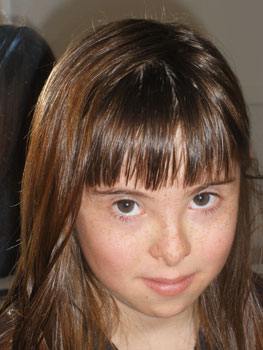Autism Spectrum: “Celeste’s Story”
Beverly G.
As of March 2001
NACD has helped my autistic daughter make incredible progress over the past fourteen months. I believe it is nothing short of a miracle.
My daughter Celeste was diagnosed as mildly autistic when she was 4 years old, but I had known for some time that she had delays. She was a normal baby, possibly less talkative than her older sister, but I wasn’t concerned. She was happy, alert, and interested in her surroundings. Between the ages of two and three, however, she didn’t make much language progress. She could quote Barney programs, and she sang almost constantly, so I knew it wasn’t a lack of intelligence or deafness. When she was 3, she started screaming when she was upset – particularly in public. She could scream for half an hour to an hour, without stopping, and our trying to calm her down or reason with her didn’t help.
By the time she was four, she only responded to about 50% of our questions. She often ignored us when we called her name. She would make requests, “I want a drink of water,” but rarely conversed. If I asked her, “What is your name?” she would respond, “What is your name?” She slept poorly, often waking up for hours in the middle of the night. She was fascinated by her reflection in the TV screen, windows, and mirrors. I took her to the public school to be evaluated for a special preschool for children with language delays. They were unable to evaluate her because she huddled in a corner, refusing to make eye contact or respond. The evaluator gave me the titles of some books on autism and Celeste was accepted into the preschool program for the upcoming fall semester.
Over that summer, I learned about autism and bought a manual of ABA methods. Armed with M&Ms as rewards, I worked with Celeste, teaching her to look me in the eye and to respond appropriately to simple questions. We played with puppets and Barbie’s to pattern correct social interaction. I saw some progress, but it was slow. I found that although Celeste would answer some questions and converse, she wouldn’t talk for more than one, possible two sentences. There was almost no back and forth conversation. Also, although she could appropriately answer some questions at home, in public, she might stress out and be silent or answer inappropriately.
In the preschool, she worked with speech therapists and others. Again, she made progress, but she was still years behind her peers in social and language abilities. She would not talk about past or future events. At the age of five, she had little fear and twice bolted into the street. Combing her hair was a nightmare. No matter how gentle I tried to be, she screamed as if she were being killed. She still screamed and became irrational when she was upset, and it was difficult to know what triggered her upsets. The background music in some videos bothered her and she would leave the room if they were on. In November of 1999, Celeste was evaluated by Easter Seals. They found that her fine motor skills were somewhat delayed, and that her gross motor skills were a year and a half delayed. I kept asking other parents about therapies they had tried that worked with their autistic children. Eventually someone referred me to a NACD mom. I spoke to her and, for the first time, thought, “This sounds like it will work.”
As I listened to the Parenting Tapes, I knew I had found what Celeste needed. Celeste was evaluated by NACD in December of 1999. I told myself that for the next year, her program was my highest priority. And what a year it was. She’s improved physically, academically, and in language and social skills.
One of the first things people noticed was her increased social ability. At the end of January, some relatives who hadn’t seen her for two months were impressed with her progress. Celeste has a cousin six months older than she. This cousin tended to play with my older daughter, but after five to six weeks of program, they were more socially equal and played happily together. Before, Celeste would play with company for a few minutes, then retreat to her bedroom. Now she plays with company for an hour or longer, with no need to retreat.
By February, teachers at Celeste’s preschool said she was making progress almost daily. She had stayed back in preschool, rather than go onto Kindergarten, and by April, the teachers thought she was ready to skip Kindergarten and go onto first grade. She has done well in first grade with some assistance from aides and some small group tutoring.
By March, Celeste began initiating games with her little brother. “Do you want to play horse school?” she’d ask. They lined up their thirteen plastic horses and played school for more than half an hour. I heard wonderful sentences like, “Now it’s time for circle time. Sit on your mat.” She was also able to memorize short poems and recite them on the phone to Grandma and in person to my adult friends.
By the spring, I noticed that Celeste’s sleeping patterns had improved. She doesn’t wake up in the middle of the night and stay awake for hours anymore.
In May, at her birthday party, Celeste was a charming, happy hostess. With a little prompting, she was socially appropriate – saying, “Come again soon,” when the guests left. Celeste was re-evaluated by NACD in May. Most of the echoalia was gone by this time, although she still “babble” talked sometimes at the end of the day when she was tired. Now I never hear echoalia, and the babble talk is very rare. She still gets upset and screams sometimes, but now it is all with words, so we know why she is unhappy.
By the summer, I noticed that she wasn’t protesting as much when I combed her hair, and by the fall, she started combing and braiding her own hair. She still doesn’t like tangles, but she’s not screaming anymore when I fix her hair.
In June, Celeste started asking “why” questions, and in December, she answered a “why” question for the first time in her life. Now she can discuss stories from books and videos.
As the year progressed, Celeste acted more appropriately in more social settings. In September, she played with another first grader at the park, taking turns on the monkey bars, telling her, “That was a good try,” etc. As I watched, I got teary eyed, because she fit in. No one watching her would think she was anything but normal. A few months earlier, she would have asked, “What is your name?” possibly ten or twenty times. Sometimes she is still socially awkward or delayed, but the emotional meltdowns in public are rare now.
In September, Celeste asked me to spell a word for her for the first time. By January 2001, she was writing sentences by herself, coming up with little stories and illustrating them. She is also reading primer level books. She is passing spelling tests in first grade. In December 1999, Celeste could not count to 10. Six months later, she could count to 100 and recognize numerals, and do simple addition and subtraction word problems.
In November, I used methods I learned in the NACD SHIFTING GEARS COURSE to help Celeste prepare for a class presentation on “What I want to be when I grow up.” Celeste stood before the class and several parents and gave her presentation in a clear voice, reciting eight memorized sentences word perfectly and showing two visual aids.
Also in November, a friend of mine who hadn’t seen Celeste in a year was amazed by her progress. A year and a half before, Celeste had always reached for my friend’s shiny gold jewelry (wanting to lick it). Now she talked to her pleasantly and answered a few questions. She also successfully attended a birthday party with her father at a crowded skating rink. Any parent of an autistic child knows what a milestone that was – she was in a strange, noisy environment, learning a new skill, surrounded by strangers. She came home happy and eager to tell me about the party.
In January of 2001, Celeste went back to a singing and dance class she had not attended for an entire year. The teacher said, “She’s a different girl. She doesn’t get upset anymore, and she smiles at me while I’m teaching.” At church, many people tell me how wonderfully she is doing. A year ago, she couldn’t sit quietly on a pew during the service. Now she tells the boys behind her to “shhh.” She points to words in the hymn book, following along. In Sunday School, she participates, answering questions and volunteering to read. A year ago, she still cried a lot at church, and if asked a question, often responded with babble talk or silence.
Before NACD, Celeste had poor muscle tone. She would run or skip with my other children, but after a minute or so, would stop and rest. She didn’t have the stamina to continue. After doing deep pressure exercises with her, I saw her muscle tone increase. Other exercises strengthened her upper arms. Today, she is a strong, muscled little girl who loves to swing on the monkey bars and run around the house. She often tells me, “I’m going to run now,” – something I never heard a year ago. I know the NACD exercises made the difference because she had been going to the park and the school playground for more than two years with little progress before.
Celeste’s program has required work and dedication on my part, but without NACD I wouldn’t have known what to do. Like so many parents, I was searching for anything that would help my daughter. I was working with her, and she was making some progress. Then I found NACD, and she started soaring.
NACD, particularly THE LISTENING PROGRAM, has also helped my two other children with ADHD and speech delay. Their articulation, language ability, and ability to follow directions has improved.
Every time I talk to NACD personnel, I am encouraged. When Celeste was first evaluated, I was told, “Don’t set limits.” She still has a few sensory and developmental issues to work on, but I believe that with NACD’s help, she will continue to make progress, and the day will come when the so called “experts” will think that her autistic label was incorrect. I know better.



